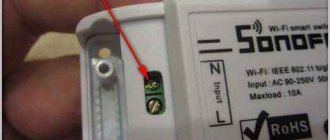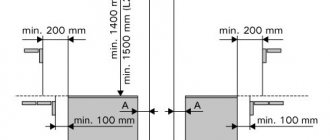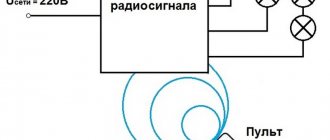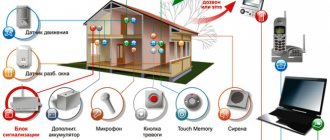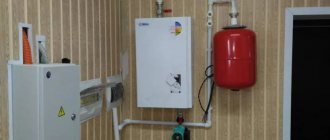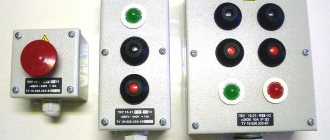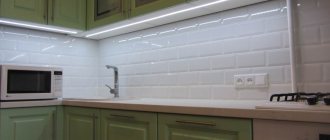Properly designed remote lighting control makes it possible to correctly turn on and off light sources located at a distance, weaken or increase the overall illumination intensity and activate emergency lighting devices in case of urgent need.
The presence of a “smart” system increases the level of room comfort, significantly reduces energy resource consumption and allows you to control lighting equipment without being on site.
In this material we will tell you how to properly organize the installation of remote lighting, about the types of control devices and the rules for self-installation of remote control systems.
Classification of remote control devices
Remote lighting control systems are automatic , semi-automatic and manual .
The former manifest themselves most effectively in large-sized residential cottages, buildings and structures, on large plots and large-scale local areas.
Through an intelligent controller they are connected to a computer and programmed to perform tasks of any complexity. They are expensive, but they completely take over the control of lighting at the site.
Using an automatic remote lighting control system, you can provide targeted light to designated areas in areas of any size at strictly defined times.
Semi-automatic systems work well in private households where it is not necessary to control a large number of light sources.
Manual options provide for remote control of one or a group of lighting fixtures using a remote control or controller. Installation of such modules is very simple and does not require the participation of highly specialized specialists.
Let's take a closer look at each of the options.
Type #1 - automatic control equipment
The main task of automatic systems (ACS) is to provide energy-efficient lighting in residential and work buildings.
The hardware and software complex not only controls the timely activation and deactivation of the light flow, but also implements the progressive Daylight .
This allows you to continuously maintain a level of illumination in the premises that corresponds to generally accepted basic standards.
Based on sensor information, the automated control system can independently reduce the brightness of the artificial light flux when a sufficient amount of daylight enters the room. This helps reduce energy consumption
Remote systems designed for automatic control of lighting devices and elements are divided into two main classes:
- local;
- centralized.
Local type equipment controls one group of luminaires. The centralized complex allows the connection of an unlimited number of separately controlled light sources to the communication node.
Local control systems . Local control units are placed in small-sized, compact housings and are mounted directly on the lamp or lamp bulb.
Sensors that record the signal are a single electronic communicator built into the system.
Lighting devices equipped with additional sensors can exchange current data with each other via the electrical network. This function allows you to provide lighting in a certain area of the building even if there is only one person there
Local-type remote devices are divided into two groups according to the scope of control. The first includes control units for certain lighting devices, the second includes complexes that regulate the level of lighting of the entire room as a whole.
Centralized automatic system . The basis of centralized control equipment is microprocessors capable of simultaneously regulating the full operation of several hundred light sources.
Communicators with this configuration not only manage the process of lighting rooms, but also competently interact with telephone networks, fire alarms and other engineering systems (security and safety, ventilation, smoke exhaust, air conditioning and heating).
Additionally, centralized-type complexes pick up signals from local sensors and supply control pulses to lighting fixtures under control.
If a room or building has areas with different levels of natural light, the control system takes this into account. Activation and deactivation of lamps occurs in rows or separate groups, depending on changes in the amount of light entering the room during the day
Processing and transformation of signal information is carried out within a single node.
This opens up wide possibilities for manual control of lighting in buildings of any scale and significantly simplifies making the necessary changes to the basic algorithm of the light supply system.
Type #2 - semi-automatic control option
Semi-automatic control systems are a unit with several toggle switches, built into the distribution board.
They are programmed to activate and deactivate lighting in certain rooms and areas of the local area at a time convenient for the owners. They do not provide for connection to the control system of all residential premises, work buildings and parts of the adjacent area.
Type #3 - manual devices for lighting control
Special remote controls allow you to manually turn the lights on and off remotely.
Based on the type of signal, they are divided into two groups:
- radio controlled;
- infrared (IR).
Radio controlled . Devices using radio waves do not pollute the airwaves during operation and correctly send a signal to a light source located outside the immediate visibility zone.
The basic range of the devices is about 100 m, however, this figure is reduced by 3-4 times if there are natural obstacles in the room or in the adjacent area.
To increase the coverage area of the radio-controlled remote control, you can install additional repeaters. With their help, the signal will reach even the most remote rooms and rarely visited corners of the site
Group of IR devices . The infrared device works reliably and clearly transmits commands, but only in line of sight.
It has a small radius of influence and sends an impulse over a distance not exceeding 12 meters in the presence of a powerful transmitter.
Some manufacturers complete radio remote controls with one or more key fobs configured to control a specific group of devices. This element is convenient to attach to your car keys, so as not to carry the main remote control with you.
Standard infrared-type manipulators have from 5 to 7 buttons programmed for a specific action.
Radio wave devices have 7-10 buttons that can control not just one device, but a configured group. For example, in one click you can activate the lighting in the garage area and at the same time open the gate for a car to enter.
Basic provisions
The TUYA platform is based on cloud technologies. A mobile device (smartphone or tablet) connects to the Internet via Wi-Fi and connects to a cloud service, which takes care of the main setup and configuration of the system. A special application is installed on the mobile device. The user selects a scenario or a single command, the signal is transmitted to the cloud. The cloud service already determines which actions need to be launched on which devices.
The creators of the platform declare that it supports a large number of communication protocols. But the developers of the Arlight TY series equipment chose only two of them - Wi-Fi and Bluetooth. This approach simplified the installation of equipment and reduced the overall cost of the proposed solution.
Some devices connect to an access point implemented using a home router directly via Wi-Fi. But managing all smart home devices only via Wi-Fi is difficult, if only because the number of simultaneous connections to one access point is limited. This is especially true for lighting control, since a home typically has more lighting fixtures than can be supported by a single residential access point.
Therefore, Bluetooth Mesh technology, supported in Bluetooth protocol version 4.0 and higher, is widely used to control smart home actuators. This technology is characterized by the fact that the same device operates both as a signal receiver/transmitter and as a bidirectional repeater. In this case, individual devices automatically self-organize into a network with intelligent routing of transmitted information.
If communication along a direct path between two network nodes is impossible due to high signal attenuation or strong interference, information is transmitted along one of the bypass paths. This function is important for modern buildings, literally crammed with all kinds of radio-electronic equipment that creates interference.
The converter is designed to interact with Bluetooth devices. It connects to the Internet via Wi-Fi and interacts with actuators via Bluetooth. In addition, devices that support Bluetooth Mesh can be controlled directly from a mobile device.
Equipment for the control complex
The lighting control complex is a multifunctional communication unit with wide optional capabilities.
It combines lighting devices, sensors, photocells and other auxiliary devices into a single intelligent system.
The lighting control system is controlled not only through a touch screen or remote control, but also through advanced mobile applications and web interfaces for computers, smartphones and tablets
If necessary, the network operates completely independently in the established mode and does not require constant user participation.
Additionally, the complex may include:
- automatic switches with the option of self-activation and deactivation;
- dimmers that can automatically adjust the power level of light flux in enclosed spaces and open locations;
- lamps with extensive functionality - automatic switching on and off, increasing or decreasing power, changing the color temperature and shade of the supplied light;
- LED strips with additional options and RGB-type control controllers;
- sensors for motion , light, presence in the room, opening of doors and windows;
- remote switches.
Properly configured control equipment operates reliably and interacts correctly with fire alarms, HVAC and other systems present in the premises.
Control units are communication nodes with buttons on the body panel and correctly turn on and off lighting fixtures.
Some models control the intensity of the light flow and its brightness, and have the ability to receive and process remote control signals. The block buttons are independently programmed for specific actions.
The communication unit can not only control the switching on and off of lights, but also remotely control various automatic electronic systems, such as garage doors or blinds.
Controllers are simplified elements for remote control of lighting networks.
They are manufactured in a wall-mounted design and are usually mounted at the entrance to the room. Remotely activate and deactivate lighting devices according to the established program.
Initially, the module is configured by the manufacturer for a standard operating algorithm. You can make changes to the operating mode through the connected LCD display and keyboard.
The program begins to operate by receiving a signal from sensors, timers, the remote control, or by manually pressing buttons on the controller body itself.
RGB-type controllers are used for remote control of LED strips.
They have wider functionality and regulate parameters such as:
- on/off;
- lighting brightness;
- glow range.
Using these control elements, you can change the tone of the light flow, adjusting it to the situation or mood.
Sensors belong to the auxiliary elements of the control system and respond to changes in certain parameters.
Families with small children should equip their premises with motion sensors. This ensures that the child is never left indoors without lighting.
Motion-detecting modules activate the lights when a user enters the room and turn off the lights when the room is empty. This makes it possible to use energy resources efficiently and not pay a lot of money on utility bills.
Light level sensors are most useful in outdoor systems. They promptly turn on the lights in the local area when it gets dark outside, and promptly turn them off when the sun rises.
This method of remote control allows you to save energy and reduce the operational load on street lighting devices.
Time relays and timers make it possible to control lighting according to a specific schedule. The user can set the required interval for turning on and off the equipment independently.
Read on to learn how to connect a time relay.
Some device models are equipped with a microprocessor and are subject to programming for specific tasks.
There are control buttons on the body of electronic time relays. By pressing, the user can set the required range for switching system operating modes
Photocells control the natural light in a room or open area.
When the light flux level decreases, the artificial light supply is activated and its intensity is increased as needed. They do not react to sudden bright flashes and take into account only the general background illumination.
Wi-Fi equipment
At the time of writing, devices with Wi-Fi control were represented in the Arlight TY series by the TY-501-DIM-WF-SUF dimmer, as well as the TY-701-WF-SUF and TY-706-WF-DIN relay modules. All of them are designed to control equipment with a supply voltage of 230 V AC.
The TY-501-DIM-WF-SUF dimmer is designed for a load of up to 1 A. The peculiarity of this dimmer is that it is assembled on a modern element base - MOSFET transistors, which ensures high technical characteristics. But at the same time, like a conventional TRIAC dimmer, it works with phase cutoff. This feature ensures compatibility with most models of dimmable lamps, including LED ones.
The TY-701-WF-SUF relay module has one switching channel, the load current can reach 5 A.
TY-706-WF-DIN relay module can control load via 6 channels
The most complex actuator is the TY-706-WF-DIN relay module. It has 6 switching channels: 2 with loads up to 16 A and 4 with loads up to 10 A.
This module can be placed on a DIN rail. For operation at a considerable distance from the access point, as well as inside a cabinet with equipment, the walls of which weaken the signal (but there should still be a dielectric window, for example, made of glass), a whip antenna with adjustable orientation is provided. In addition to Wi-Fi, the TY-706-WF-DIN relay module supports control via the MODBUS interface. A description of this feature is beyond the scope of this article.
Recommendations for arranging lighting controls
The choice of suitable elements for organizing a lighting control system directly depends on the object that needs to be taken under control.
It is necessary to buy components only in specialized stores, giving preference to products from trademarks and brands that have proven themselves in the market.
Subtleties of organizing a control system in an apartment
For a standard city apartment, installation of the system is advisable if there is multi-tiered internal lighting.
A chandelier, wall sconces, ceiling lamps and other light sources in the room are connected to the control unit. Full or partial activation/deactivation of lighting devices is carried out via a remote control.
In the living rooms of the apartment, using the remote control, you can change the lighting intensity and perform spot lighting of certain areas or interior elements
It is wiser to install motion sensors in sanitary areas. Then the lights in these rooms will turn on only at the time of the visit, and turn off 1 minute after the user leaves.
Tips for cottage owners
A small private house with a minimal surrounding area should be equipped with a semi-automatic lighting control system. This will not require large expenses, but will increase the comfort of your stay.
You can connect a spotlight above the entrance gate, lights along the path to the house, and lamps in the hallway and living room to the module.
Remote control of the lighting system in a private home is available via a mobile phone. To do this you need to install a special application with a client interface
In large-sized cottages with a vast local area, automatic remote control systems are most effective, including not only basic components, but also additional sensors, timers, dimmers and controllers.
The presence of such elements allows you to control every aspect of lighting not only indoors, but throughout the entire surrounding area.
Application of "smart lighting"
Smart lighting equipment is designed to control indoor and outdoor lighting fixtures. Every lamp in the house, garden lights, spotlights and various lighting are connected here. Also, a centralized device regulates the operation of all devices.
Controllers are used to connect to the network, and sensors and detectors are used to record activities. For example, the sensor registers any changes in lighting - the onset of evening and night, and depending on how dark it is outside the window, turns on the lamps with a certain brightness level. The last operation is performed not by the sensor itself, but by the controller. The sensor sends a signal to it, the controller processes it and decides what to turn on and where.
Main advantages of control systems
Initially, the ability to remotely control lighting was only available in expensive and advanced smart home systems. Now the situation has changed and the function has begun to be implemented in simpler control complexes and blocks.
One of the main advantages of the control system is the ability to control groups of devices or individual light sources from a single client interface
Remote equipment has many useful qualities and advantages.
Among the main advantages are the following important positions:
- Ensuring the security of the premises in the absence of owners . System control is available through any modern gadget with Internet access. Property owners, when going on a business trip or vacation, can program the lights to automatically turn on/off, simulating the presence of residents in the house or apartment.
- Saving money and materials during installation . To install the simplest remote control system, you do not need to buy a cable, hire workers to groove the walls, and spend additional money in the future on replacing wires.
- Independence from voltage surges and emergency power outages. In many advanced control systems, the cabinet, automatic machine and touch switch with the remote control are in contact via radio waves and do not require the presence of an energy resource in the network.
- Financial feasibility . Remote control units allow you to use electricity as efficiently as possible and illuminate only the necessary objects, rooms and territories at any given moment. With this approach, the efficiency of the lighting system increases, and energy consumption decreases without compromising the comfort of property owners.
These parameters make the systems a relevant and popular technical solution for remote control of lighting equipment.
What are the benefits of wireless switches?
- No need to drill into walls for wiring
- An excellent solution for a wooden house; sometimes it’s impossible to make hidden wiring
- You can even install a switch on a piece of furniture
- You can move the switch to another location at any time
- One source can be controlled from several places
Self-installation rules
Local and centralized remote control systems are integrated into the existing electrical wiring on site. In this case, powering the circuits with working resources from lines supplying electricity to lighting devices is permitted.
The role of current circuit breakers is played by switches that react to the receipt of a signal.
“Sophisticated” control modules have expanded functionality and have the ability to change internal network parameters, turn off certain zones from lighting and leave lighting at the optimal level only in those rooms where it is appropriate at a particular moment.
All the elements necessary for independently setting up a lighting control system at a distance can be purchased in specialized stores or ordered online
Self-installation of the remote control complex at home is acceptable.
But for this you need to follow the basic fire safety rules and take the following steps in the specified sequence:
- De-energize the wiring in the room through the panel and install a sign warning about the work in progress.
- Carefully remove outdated push-button switches using a profile tool.
- In the vacant spaces, place multifunctional electronic devices equipped with a receiver, signal decoder and disconnector.
- Securely insulate the contact area between the network wires and the working board of the remote control unit.
- Activate the electrical current supply and carefully test all elements of the control system for serviceability and functionality.
- If no problems are identified, proceed to operation.
If you do not have practical experience working with electrical devices, you should not take on the task yourself. It is better to use the services of professionals and entrust them with the installation of control equipment.
Outdoor automatic lighting
In recent years, there are fewer and fewer country houses without automatic lighting systems for outdoor equipment. Special sensors regulate the operation of outdoor lamps, registering changes in street light. Electrical devices turn on at dusk. The darker it is outside, the brighter the artificial lighting. Night mode is possible, when devices are turned on only in the presence of people.
You should use automatic lighting control as part of a smart home system in cases where you are pursuing one or more of the following goals: ease of use of lighting devices, saving electrical energy and protecting real estate from intruders by simulating presence. Despite the high cost of installation, it quickly pays for itself.
Functionality
The functionality of the system is selected taking into account the requirements of a specific consumer. Depending on the configuration, it allows:
- Adjust the level and order of lighting in each room;
- Ensure automatic switching on when darkness falls. The products are equipped with special sensors that send a control signal as dusk sets in;
- Connect indoor lighting with motion sensors. The lamps will turn on as a person moves through the room or around the house;
- Ensure the execution of the lighting script;
- Beautifully decorate the façade of the building and the area adjacent to the building. Lighting is used to mark paths and gardens. The scenario for changing the luminous flux is selected taking into account the desired effect;
- Change the brightness of the light when you turn on the TV. The intelligent system can act as an alarm clock. Users program the equipment so that bedroom lights turn on at designated times. A smooth increase in illumination is possible while moving around the house at night;
- Create the illusion of sunrise or sunset;
- Use backup power supplies. This is especially true for areas with unstable power supply. When the main source is turned off, the lamps start working from the backup one;
- Protect equipment from overload. If it occurs, the intelligent system will shut down part of the network. Throughout the entire period of operation, the voltage will be stabilized to prevent electrical appliances from being damaged due to a voltage surge.
When organizing smart lighting in the house, switches are changed. Instead, as a rule, a single panel is installed with touch or push-button control. It allows:
- Activate the brightness control effect;
- Implement adaptive detection of brightness level;
- Set the operating mode of the equipment in each individual room;
- Activate home presence mode.
Where in demand
Smart lighting has a wide range of uses. With its help, automatic control of devices installed inside and outside the house can be realized. This makes it possible to turn on the outdoor lighting as dusk approaches.
The smart system is relevant not only for residential buildings, but also for public buildings. Very often it is installed in sales areas, production facilities, office and public buildings. The equipment is selected taking into account the needs of a specific consumer.
Modern lighting of a new generation
The first attempt to provide flexibility in lighting control was the use of dimmers. These devices made it possible to regulate the light intensity electronically and mechanically. Dimmers have been replaced by a more global solution - systems based on the DALI, LON and BACnet protocols. They provided centralized lighting control through a controller and the ability to integrate artificial light into a single complex with other engineering networks (alarm, heating, ventilation). The main disadvantage of such systems was the complex cable infrastructure, which included power, low-current and additional lines. A huge network of wires created the need to spend a lot of time and effort on its installation, maintenance and repair.
The rapid development of LED devices and PoE (Power of Ethernet) technology gave impetus to the emergence of a new generation of intelligent light control system - Led Intelligent System. Its main feature is the use of a single cable. PoE technology provides simultaneous transmission of data and electrical energy over twisted pair Ethernet. This makes it possible to reduce the size of the cable infrastructure, which significantly simplifies the connection, operation and maintenance of the entire lighting system. In addition, PoE technology increases the number of devices that can be integrated into a single complex. The power of connected devices is currently limited to 60 W, but in the near future it is expected to increase.
